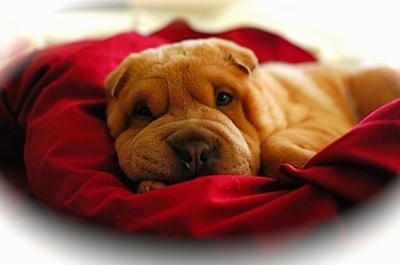
Fiona the Mini Shar-Pei as a puppy
Miniature Chinese Shar-Pei
Mini Shar-Pei
MIN-ee-uh-cher shahr-pey 
The Miniature Shar-Pei shall be short, broad and almost square in proportion of body length to height. The most notable characteristic is the abundant, tight wrinkling about the head and body. The head should be slightly large in proportion to the body. Eyes should be dark, clear and almond-shaped, and neither sunken nor protruding. In dilute dogs, the eye color may be slightly lighter. Eye tacks will not be allowed in the ring. Ears should be small, triangular, thick, lying close to the head and preferably curled back at the edge. They should set wide apart and forward on the skull and angle toward the eye. They may show a slight degree of mobility. Prick ears are a disqualification. The skull should be flat and broad with a moderate stop, with the plane of the forehead and top of the muzzle parallel. The muzzle should have adequate bone with enough padding to give a square appearance to the head with no hint of snipiness. The flews should be slightly flared. The nose is large and wide and may be darkly pigmented or conform to the general coat color of the dog. On lighter colored dogs, a brick nose is acceptable. Tongue and inside of the mouth is preferably bluish-black. The tongue may lighten somewhat due to heat stress. Teeth - a scissor bite is preferred. Deviation is a fault. The neck is of medium length, muscular, set well into the shoulders with abundant dewlap. Topline dips slightly behind the withers and rises somewhat over the loin. The chest is broad, deep, with the brisket extending to the elbow, rising somewhat under the loin. The croup curves slightly downward to the high set tail. The tail is thick at the base, tapering to a point and should curl. Tail carriage should be up and over the back. The absence of a complete tail is a disqualifying fault. The shoulders are muscular, sloping and well laid back. Forelegs, when viewed from the front, should be straight, moderately spaced with elbows close to the body. Viewed from the side, the forelegs are straight with adequate bone, the pasterns strong and flexible. The feet are proportionate to size. Removal of front dewclaws is preferred. Thighs are muscular, full and well defined with moderate angulation. The well-let down hocks are short and perpendicular to the ground and parallel to each other when viewed from the rear. Rear dewclaws must be removed. The acceptable coat length may be short horse coat up to a brush length not to exceed 1 inch at the back of the neck. Texture may range from moderately harsh to soft, without being wavy or excessively thick. Only solid colors are acceptable. A solid color dog may have darker shading down the back and on the ears or darker hairs throughout the coat, as in the sable. Not a solid color is a disqualifying fault. The gait is balanced and free-flowing. Both front and rear legs should tend to converge on a center line with strong forward reach and rear drive.
The Miniature Shar-Pei should be alert, confident, playful, adaptable, affectionate, easily trained and inherently clean and quiet. The Mini Shar-Pei is very loyal to his handler, intelligent playful, active, dominant and brave. It bonds with its family, but is not unfriendly toward strangers. If the dog meets cats and children while it is still young, it usually will not have a problem with them. The Miniature Shar-Pei has a frowning expression, but is surprisingly easy-going, calm, independent and devoted. It makes a delightful companion and a good watchdog. The Miniature Shar-Pei needs a confident handler. If you are uncertain, inconsistent, too soft or mild, in the dog's eyes, it will take over as the boss. The Shar-Pei needs a firm, but gentle, extremely consistent authority figure. The dog must be taught all humans are above him in the pecking order. Those who see themselves as above humans will be stubborn and bold. This breed needs firm obedience training to establish your leadership. They may refuse commands from family members who have not established leadership over them. They need an owner who as the ability to be "Top Dog". The Miniature Shar-Pei generally hates water and tries as hard as it can to avoid it. Mixing other dogs can sometimes be a problem if one of the dogs is displaying dominant behaviors. Socialization is important. Some Miniature Shar-Pei are less dominant than others. The dogs temperament depends on how the owner treats the dog. Dogs that are allowed to believe they are the boss over humans will develop behavior issues. Dogs that are not taken for daily pack walks will also begin to display a varying degree of issues. A lot of this breed’s health issues depend on the lines it comes from. Good Shar-Pei lines will not have skin problems, which is a hereditary condition.
Height: 17 inches and under (43 cm)
Weight: 25 - 40 pounds (11 - 18 kg)
Fevers of unknown origin or swollen hocks syndrome may be the early stages of amolydosis (kidney failure). One misconception is that the Miniature Shar-Pei have skin problems due to their wrinkles. Yes, some Miniature Shar-Pei have skin problems, but it is not because the dog has wrinkles, but rather a hereditary condition. Due to over-popularity in the 1980s, some Shar-Pei do have hereditary skin problems. However, if you buy from a reputable breeder, this condition should not be a problem. Be sure to find a breeder who strives for healthy dogs.
The Miniature Shar-Pei will do okay in an apartment if it is sufficiently exercised. It is moderately active indoors and will do okay without a yard. Because of its padded head, the Miniature Shar-Pei is very sensitive to heat. Shade and water must always be available. Provided it gets enough exercise, it will be very peaceful indoors.
The Miniature Chinese Shar-Pei have a considerable need for exercise, which includes a daily walk. While out on the walk the dog must be made to heel beside or behind the person holding the lead, as instinct tells a dog that the leader leads the way, and that leader needs to be the human. Do not over exercise them in the heat, as they are sensitive to it.
Up to 10 years
About 4 to 6 puppies
The Miniature Shar-Pei should be brushed regularly. Their coat is never trimmed. This breed does not have an undercoat. The "bush" coat sheds a little year round, but the "horse" coat tends to shed only during molting periods. Molting may leave the dog looking unkempt. Bathing about once a week and brushing the coat daily during this period will remove the old, dead hair and allow the new coat to grow in. Some owners are allergic to the harsh coat.
The Miniature Shar-Pei is being developed as a downsized version of the Shar-Pei. It is a purebred Shar-Pei and the miniature size comes from a recessive gene that these dogs carry in their DNA. The hope by breeders is that by selective breeding, the recessive gene will soon become dominant in the breed. The Mini Shar-Pei is recognized by the AKC as a Shar-Pei, however the size of this dog is not recognized by them and is considered a fault in the show ring. The ancestry of the Shar-Pei is uncertain. It may be a descendant of the Chow Chow, however, the only clear link between these are the purple tongue. However, pictures on pottery suggest the breed was present even in the Han Dynasty (206 BC). For many years the Shar-Pei was kept as a general-purpose farm dog in the Chinese countryside, used for hunting, protecting stock, and guarding the home and family. During that time the Shar-Pei was bred for intelligence, strength and its scowling face. Later, it was used in dog fighting. The loose skin and extremely prickly coat were developed to aid the dog in fighting, making the Shar-Pei difficult for the opponent to grab and hold on to. During the Communist Revolution, dogs were rescued by a Hong Kong businessman named Matgo Law, who appealed to Americans in 1973 through a dog magazine to save the breed. From those few specimens, the Shar-Pei fancy has grown tremendously over the past decades. Now the Shar-Pei is in the Non-Sporting Group of the AKC with over 70,000 dogs registered as foundation stock. When first introduced, Shar-Pei were astronomically expensive. Now they cost about the same as any other purebred dog.
Southern, AKC Non-Sporting
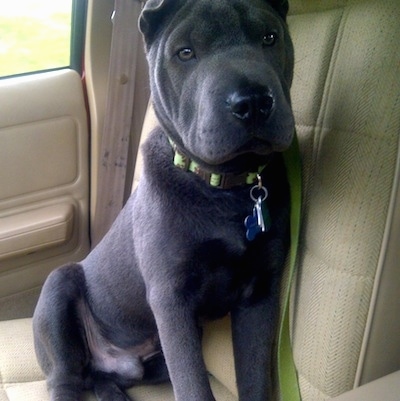
"Winston is 6 months old, 32.7 lbs., 11 inches high, 23 inches in length. Winston is now a full-fledged guard dog, he has grown into a perfectly obsessive compulsive barker, and despite pleads, classes, collars and personal training, is committed to barking at everything that dares make noise. He is strong willed, attentive and full of energy always. Winston's eyes have gone from blue to brown but that was expected. No surgeries needed for any extra eye skin; he has mostly lost his wrinkles.
"Although it is difficult to keep his attention outside the house, when able to create a quiet learning environment he responds quickly and picks up commands near instantaneously. There is absolutely no denying this breed is smart, Winston can not only figure out our patterns, but when he knows he's doing something wrong he will wait until everyone is preoccupied to act. Although we have socialized him since he was 6 weeks old, he has developed 3 interesting traits. 1) Should anyone seclude him from the other parties he will scream, and by scream I do mean high pitched-wailing also included when trying to bath, groom or needles. I had resorted to buying a bark collar for Winston, but it really had no effect on him one way or the other. 2) Groups of 2 or more dark-skinned persons trying to pet or get close to him freaks him out. This is interesting because he had no early puppyhood traumas. 3) Winston is a destroyer of worlds when left alone. I believe I can attribute this to having him by my side for the first 5 months non-stop and suddenly having to go back to work and school.
"In 6 months I have learned that this breed should always been crate trained and socialized. I very strongly believe that adding a Mini Shar-Pei to a family with a trained adult dog would be most beneficial, as Winston can mimic a dog’s behavior automatically. Never stop socializing them, Winston has gotten more skittish since he's gotten older and it now takes time for him to warm up to new persons. Overall, Winston is an amazingly smart animal, he makes me laugh every day and when he is neutered I believe he will be a very calm, enjoyable animal to socialize with. He has never shown signs of aggression and is always waiting for a command, kind word or treat. Had he had more wrinkles, he would have been a great specimen to breed."
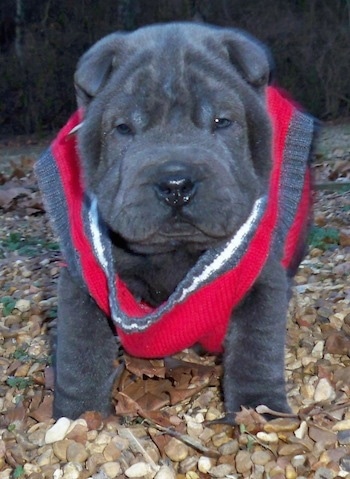
"This is Winston Chen, a Mini Shar-Pei puppy at 6 1/2 weeks old. I took this photo at the park the third day I had him. Off the bat he went to the bathroom outside, hardly ever having any accidents inside. He automatically walked next to us at the park without a leash, never running off or chasing after anyone. Winston is the most brilliant puppy I have ever met, from his lovable personality to his easygoing nature. Despite the history of the breed, he does not mind water at all, he is a chewer/biter, but listens and learns very quickly. Winston generally gets one 45-minute walk a day. Despite his stubborn streak (which comes out when we tell him "No") he is very affectionate and caring. No snoring, minimal farting in addition to his bed hogging he is a cuddle bug to everyone. We currently live in an apartment which seems to suit him fine so long as he is exercised daily. On a side note he absolutely hates the original Kong toy and wants nothing to do with it; instead he chews on the rug, socks and towels with minimal interest in tennis balls. He was born 11/28/10, at 6 weeks he weighed 5.9 pounds, at 7 weeks he now weighs 7.3 pounds. I am overall very happy with this choice of breed, I found that he is an amazing puppy despite being just that and with as much socializing as possible he will be a great therapy and family dog."
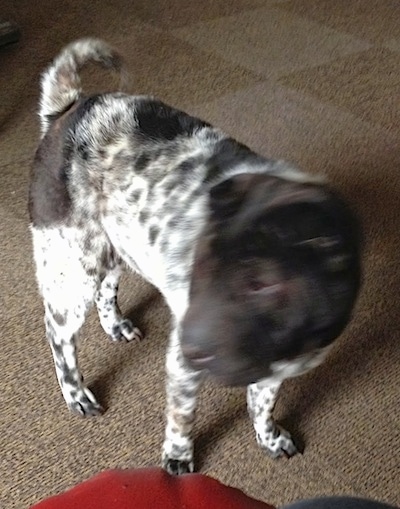
Koshue Shoio the Miniature Shar-Pei at 7 years old—"Koshue Shoio is a Mini Shar Pei. I obtained her after the death of my standard size Shar Pei. I fell in love with the breed after rescuing my first one, Taz. They can be stubborn, but are loving, loyal and friendly. They can also be very comical. My dog watches TV and seems to search behind the set to find what is on there. She is very easy to treat when needed, but she can also be very devious. She has her own dog, and prefers Chihuahua or Chi crosses. She is not happy without her pet. She loves cats as well."
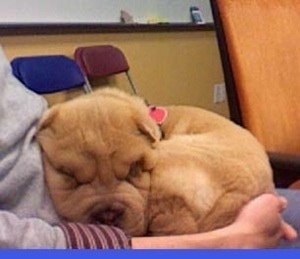
Fiona the Mini Shar-Pei as a puppy
